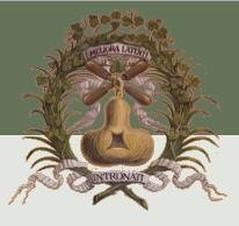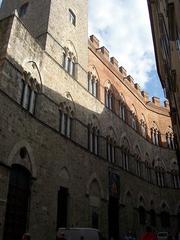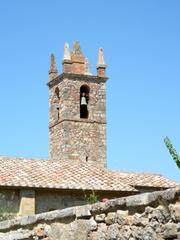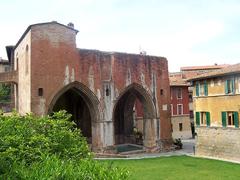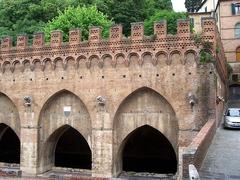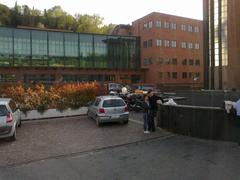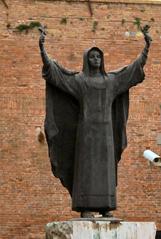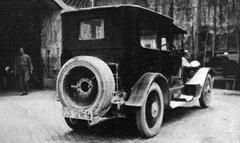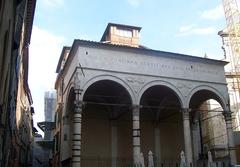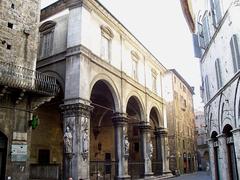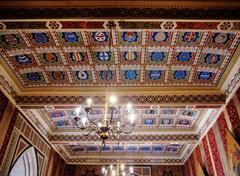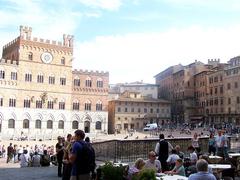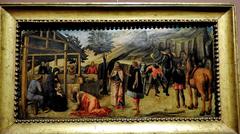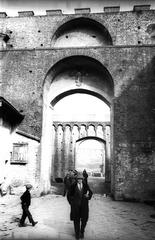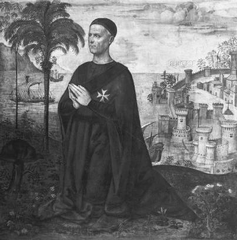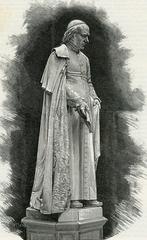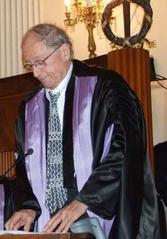Museum of the Dragon District Siena: Visiting Hours, Tickets, and Historical Sites Guide
Date: 14/06/2025
Introduction
Nestled in the heart of Siena’s UNESCO-listed historic center, the Museum of the Dragon District (Museo della Contrada del Drago) is a vibrant testament to one of Siena’s most iconic contrade. The museum offers an immersive window into the history, culture, and enduring traditions that define the Dragon District, a key participant in the legendary Palio di Siena. Here, visitors explore medieval architecture, exquisite artworks, Palio banners, ceremonial regalia, and treasured memorabilia reflecting centuries of pride and community spirit. Guided tours, often led by contrada members, provide personal insights, while the museum’s location in Siena’s medieval core makes it an accessible addition to any cultural itinerary. This comprehensive guide covers visiting hours, tickets, accessibility, and insider tips, ensuring travelers can fully appreciate this remarkable cultural institution (contradadeldrago.it, Terre di Siena, The Geographical Cure).
Table of Contents
- Introduction
- The Museum of the Dragon District: Overview
- Architectural Features and Setting
- Permanent Collections and Highlights
- Visiting Hours, Tickets, and Accessibility
- Guided Tours and Visitor Experience
- Integration with the Palio di Siena
- Nearby Attractions & Suggested Itineraries
- Frequently Asked Questions (FAQs)
- Summary Visitor Tips
- References and Further Reading
The Museum of the Dragon District: Overview
Located within Siena’s medieval core, the Museum of the Dragon District is dedicated to showcasing the rich heritage of the Contrada della Drago. Visitors discover the traditions, artistry, and unique identity of one of Siena’s 17 contrade, famed for its role in the Palio di Siena. The museum’s intimate setting and authentic atmosphere make it a standout among Siena’s historical sites.
Architectural Features and Setting
Medieval Foundations and Contrada Identity
The museum is situated in the Contrada della Drago’s headquarters, a cluster of medieval buildings with thick stone walls, arched doorways, and original architectural details dating from the 13th to 15th centuries (The Geographical Cure). These spaces, once domestic residences or guild halls, have been carefully adapted to preserve their historical character while serving as the heart of contrada life.
Interior Layout and Artistic Highlights
Visitors enter through a modest arched portal into interconnected rooms decorated in the contrada’s red and green colors and marked by the dragon emblem. Highlights include:
- Palio Banners (Drappelloni): Unique, artist-commissioned banners commemorating Palio victories.
- Ceremonial Halls: Spaces adorned with portraits, photographs, trophies, and memorabilia.
- Oratory of Santa Caterina del Paradiso: A historic chapel with religious artifacts and artworks, used for contrada ceremonies.
Original features such as wooden beams, terracotta floors, stone staircases, and faded frescoes are preserved throughout, evoking the layered history of the district.
Location Within Siena’s Historic Center
The museum sits near Via del Paradiso, within walking distance of Piazza del Campo and Siena Cathedral (FullSuitcase). Surrounded by narrow streets, traditional brick facades, artisan shops, and trattorias, its location offers a truly authentic Sienese experience.
Permanent Collections and Highlights
Palio di Siena Memorabilia
A focal point of the museum is its array of Palio di Siena memorabilia, including:
- Drappelloni: Palio banners from the 18th century onward, each telling the story of a victory (ItalyMammaMia).
- Jockey Silks and Equipment: Costumes, bridles, and racing gear used in the Palio, accompanied by archival photos and race footage.
Historical Costumes and Regalia
Hand-embroidered medieval costumes, banners, and flags, many over a century old, are displayed alongside ceremonial shields and objects featuring the dragon motif.
Artworks and Sacred Objects
- Paintings and Sculptures: Works by Sienese artists, including depictions of patron saints and religious themes.
- Ex-voto Offerings: Devotional objects commemorating blessings and victories.
Archival Documents and Photographs
Detailed records, membership rolls, and rare photographs from the late 19th and early 20th centuries provide a window into the contrada’s history (Italy.com).
Trophies and Awards
The museum displays trophies, medals, and plaques celebrating achievements in the Palio, flag-throwing, and singing competitions.
The Dragon Chapel
A small chapel is used for contrada religious ceremonies and is decorated with the dragon emblem and donated artworks.
Interactive and Multimedia Exhibits
Modern touchscreens and multimedia presentations allow visitors to access digital archives, interviews, and historical videos.
Educational and Temporary Exhibitions
Multilingual panels explain contrada traditions, and rotating exhibits cover topics such as the art of the drappellone, the role of women in the contrada, and dragons in art and legend.
Visiting Hours, Tickets, and Accessibility
Visiting Hours
- By Appointment: Museum visits are generally arranged by appointment or during special events, particularly around the Palio (2 July and 16 August).
- Special Openings: Extended hours may be offered during Palio season. Always check the official website or contact the museum before visiting.
Ticket Information
- Admission: Fees typically range from €3 to €8, with discounts for students, seniors, and local residents.
- Children under 12: Usually free.
- Tickets: Purchase on-site or in advance via the official Contrada della Drago website.
- Advance Booking: Strongly recommended during the Palio or peak periods.
Accessibility
Due to the medieval structure, some areas feature steps and uneven floors. The museum is partially accessible; visitors with mobility challenges should contact ahead to discuss arrangements (Terre di Siena).
Guided Tours and Visitor Experience
- Guided Tours: Available by reservation, led by knowledgeable contrada members. Tours are offered in Italian and often in English; booking in advance is recommended for English-language tours (AboutSiena).
- Self-Guided Visits: Multilingual panels and printed guides are available.
- Photography: Allowed in most areas, though flash may be prohibited, especially in the oratory.
- Duration: Most visits last 30–60 minutes, but enthusiasts may wish to stay longer.
Integration with the Palio di Siena
The museum plays a central role during Palio preparations and celebrations. Costumes, banners, and regalia on display are used in the parade and festivities. Visiting during the Palio provides a unique opportunity to experience the excitement and living traditions of the contrada (The Geographical Cure).
Nearby Attractions & Suggested Itineraries
- Piazza del Campo: The heart of Siena and home to the Palio (The Travel Folk).
- Siena Cathedral (Duomo di Siena): Renowned for its marble façade and mosaics (HistoryTools.org).
- Other Contrada Museums: Each offers a different perspective on Siena’s communal culture (Visit Tuscany).
Suggested itinerary: Combine the Museum of the Dragon District with nearby contrada museums and major landmarks for a full day of Sienese history.
Frequently Asked Questions (FAQs)
Q: What are the Museum of the Dragon District’s visiting hours?
A: Generally by appointment or during special events, especially around the Palio. Check the official website for up-to-date hours.
Q: How do I buy tickets?
A: Tickets can be purchased on-site or in advance via the museum’s website. Discounts are available for certain groups.
Q: Is the museum accessible for visitors with reduced mobility?
A: The museum is partially accessible; some areas may be difficult to navigate. Contact the museum in advance for assistance.
Q: Are guided tours available in English?
A: Yes, with advance reservation.
Q: Can I visit during the Palio?
A: Yes, and the experience is especially rich during this time.
Q: Is photography allowed?
A: Yes, but flash is generally not permitted in the oratory.
Summary Visitor Tips
- Book Ahead: Especially during the Palio and peak travel periods.
- Combine Visits: Explore other contrada museums for a broader understanding of Siena’s social fabric.
- Check Accessibility: Contact the museum for mobility concerns.
- Support the Contrada: Donations and souvenir purchases help sustain the museum.
- Language: Most signage is in Italian, but English tours and printed guides are available.
- Respect Local Customs: Dress modestly and be mindful of the oratory’s religious significance.
References and Further Reading
- contradadeldrago.it
- Terre di Siena
- The Geographical Cure
- FullSuitcase
- GoAskALocal
- ItalyMammaMia
- Italy.com
- AboutSiena
- Love from Tuscany
- The Thinking Traveller
- The Travel Folk
- HistoryTools.org
- Visit Tuscany
Enjoy your journey into Siena’s rich cultural heritage! For more Siena travel tips, museum guides, and audio tours, explore our related articles and download the Audiala app.
